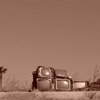Riccardo Dillon Wanke, "To R.S."
 A sensitive and spacious work, To R.S. utilizes a variety of traditional instruments (guitars, pianos, natural sounds, etc) in a completely different context, dissolving the known sounds into sparse, pure tones and subtle variations. As a work dedicated to composer Robert Schumann, it’s quite an accomplished slice of minimalism in its own right.
A sensitive and spacious work, To R.S. utilizes a variety of traditional instruments (guitars, pianos, natural sounds, etc) in a completely different context, dissolving the known sounds into sparse, pure tones and subtle variations. As a work dedicated to composer Robert Schumann, it’s quite an accomplished slice of minimalism in its own right.
Functioning as one piece divided into four logical sections, the movements flow nicely into one another, but each are distinct and stand on their own.The opening "Theme and Variations" reminded me, at least in passing, of Eleh's clinical attention to detail when it comes to employing tones and their variations.However, Wanke's tones, while carefully controlled, almost seem to bring along with them a perceptible group of imperfections:recording errors, natural interruptions, or intentionally placed there.Personally, I found them to be fascinating, and a good accompaniment to the otherwise icy, static tones.
"Turtle" turns those tones up louder and heavier, pushing into the lower frequencies but also bringing along quiet waves of sound that crash over, demanding more attention but not overshadowing the subtle undercurrent of sounds and textures.Even when the heavier sounds start to bleed into the red, they never overshadow the subtlety of sound.
These are mostly stripped away on "Joke," in lieu of heavy reverberated strings that cut harshly through, allowing silence in.Distant environmental sounds and improvised percussive elements creep in, slowly filling up the latter half and rendering it into a study in textures, as opposed to tones.The appropriately titled "Finale" even introduces conventional piano passages, extracted from Schumann's own work.The piano is overtaken by textural crackling that eventually becomes the focus, and when joined with deep, heavy melodies, takes on a post-industrial vibe.
The melody eventually becomes the focus and becomes warmer, even with an overt digital loop that goes along with it.Throughout there is a significant amount of variance in the sound before coming to a close on the same sparse, basic tones that opened the disc, allowing everything to come full circle.
Given the distinctive sound and conceptual structure of the pieces, it's hard to believe this is only Wanke's second full length release.Carefully balancing complexity and simplicity, his juggling of treated and pure sounds into true, traditional minimalism is exceptionally well done.
samples:
 



